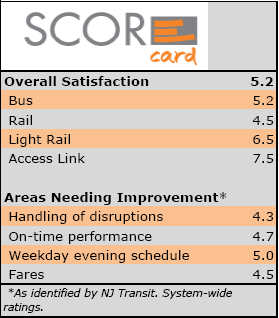I can’t remember ever receiving a 52% on a test in school and that being considered “satisfactory” or “acceptable.” Hopefully, NJ Transit doesn’t think so either.

During April and May, 19,000 riders filled out surveys rating NJ Transit in 4 areas: facilities, service/vehicles, communications, and overall. At the July 13 board meeting, NJ Transit officials released the first-ever results of this SCORE card initiative: a system-wide average score of 5.2 on a scale of 1 to 10, with rail riders the most dissatisfied (see results at right).
The Northeast Corridor rail line, serving 56,700 passengers daily, received the lowest overall satisfaction score of 4.0. Riders on the line gave NJ Transit a score of just 3.5 for “on-time performance,” and a 2.9 for “handling of disruptions.” Mechanical reliability and announcements during disruptions also got low scores, along with fares. The Atlantic City line received the highest overall satisfaction rate of 6.8.
A similar dissatisfaction was felt among New York interstate bus riders. 90,300 riders daily rely on NJ Transit bus service to bring them in and out of New York. “New York Interstate” buses received the lowest overall satisfaction among bus routes, 5.1. Again, the biggest areas where NJ Transit fell short were, “on-time performance,” “handling of disruptions,” “weekday evening schedules” and “fares.”
It’s not surprising that NJ Transit received a mediocre grade this first time out. Wounds are still fresh for transit riders stemming from the 22% fare hike and decrease in service seen last year, the cancellation of the ARC project and recent morning/evening rush hour rail delays due to ailing infrastructure. NJ Transit has gone on the record stating that there will be no fare hikes this year.
Making the Grade
Courtney Carroll, NJ Transit spokeswoman, indicated that this survey data will be used as a “baseline” for the SCORE card and “use the results to target specific improvements to customer satisfaction.” Surveys will then be conducted on a quarterly basis to not only determine customer satisfaction, but how NJ Transit responds to prior customer feedback. NJ Transit identified several areas needing improvement in the first survey go-round, but declined to comment on whether an action plan is currently in place to address them. Here are some suggestions to get state leaders started:
Fight for Northeast Corridor improvements. The line’s abysmal ratings show it needs investment that will improve reliability, such as a $450 million federal grant for electrical fixes that is at risk of being cut.
Improve the cross-Hudson commute by working with the Port Authority to add a second Manhattan-bound bus lane leading up to the Lincoln Tunnel in the morning and a westbound bus lane during evening rush hours. This will allow for additional NJ Transit buses and help ease congestion along the cross-Hudson commute, addressing the low scores from interstate bus riders. NJ Transit should also work along with PANYNJ to resolve the bus parking issue so NYC-bound buses do not have to return to NJ after the morning commute.
Institute bus rapid transit in select cities. NJ Transit has made some small steps towards implementing frequent, fast BRT through “Go Bus” in Newark and Bloomfield. Increased service (as promised by the Christie administration) and the use of bus-only lanes, pay-before-you-board fare collection, and other BRT improvements would make life easier for bus riders concerned with on-time performance and weekday evening schedules.
Image: TSTC graphic using NJ Transit data.

And NJ TRANSIT’s bicycle accommodations and policies are halfhearted at best. I heard that it was a fight to get bike racks on the new Northern Fleet Buses that are entering service even though such accommodations are pretty much considered standard in the industry.
For comparison, Caltrain (South SF Bay area) just spent $300,000 to convert more old passenger cars into bicycle coaches so that most trains can carry up to 80 bikes each! The project was done 6 months ahead of schedule to boot!
NJ Transit needs to modernize their fare system. It’s ridiculous that you still need exact change or a monthly pass to ride NJT buses; in fact, this is one of the primary reasons I don’t ride the bus, because I rarely carry change. In NYC you can use a metrocard for both the buses and subway. In London, the “Oyster Card” goes even further, which can be used for bus, subway, national rail, light rail, etc.
Also, NJT needs to implement a live bus tracking system so that rides can know approximate arrival times of buses. This has been very successful in many European cities and Chicago and San Francisco (NYC has been slow to catch on), and can really be a game-changer for improving bus service quality.
Everyone knows what has to be done but they refuse to do it. Train announcements and departures at Penn station have a window of 10, yah more like 3 minutes at best before the train departs the station. This requires passengers many paying a high rate of fare to act like cattle pushing through a pen. Why cant trains accept passenger with a little more time and the staff at their posts. If you have the company run by political implants and a board of the same ilk, the worker bee know they are the ones who real run the railroad and the service standards are tailored to their pleasure.
[…] has been rolling out efforts to acquire feedback from its customers. To complement the “SCORE Card” initiative, NJ Transit is holding public forums “to hear about your […]